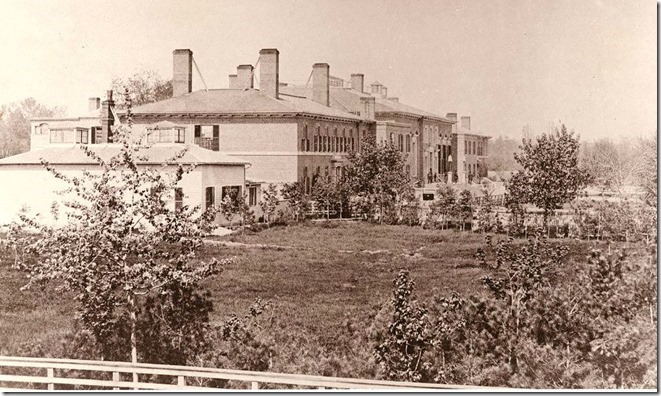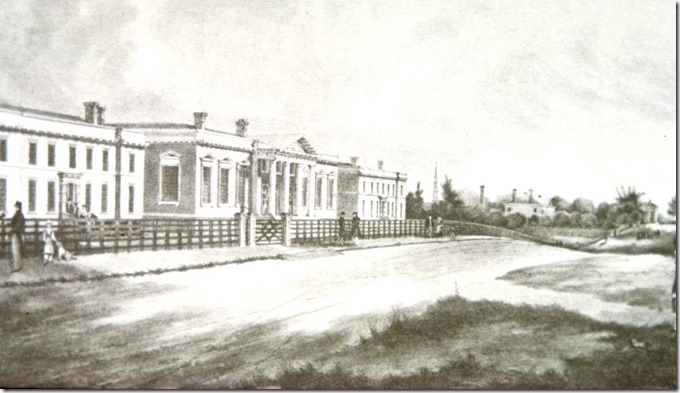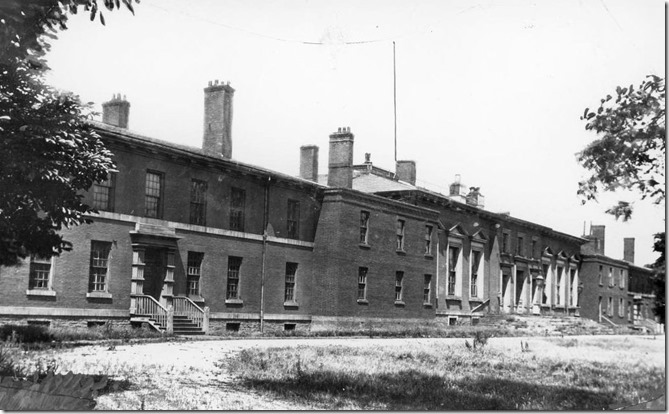Parliament Buildings on Front Street in 1854 (Toronto Archives, F1498, id.0010(1)
After the second parliamentary buildings at Front and Berkley Street burnt, until new buildings were erected, the members of the assembly met at the vacant hospital on the northeast corner of John and King Street West. The hospital was empty as although its construction had been completed, there were no funds to furnish, equip and staff the facility. However, in 1829, the hospital regained possession of the premises, as funding had been secured. Members of the legislature relocated to the York Courthouse on the northwest corner of King Street East and Church Street. This building, designed by John G. Howard, was built in 1827 and demolished in 1853.
Watercolour of the York Courthouse where the assembly met. It was designed by John G. Howard. Toronto Reference Library r. 3942(1)
There was considerable disagreement over where to build new parliament buildings, many members of the assembly favouring reconstruction on the site of the ruins of the previous structures. Others argued that the site was unhealthy due to the malarial swamps near the mouth of the Don River. Finally, they decided to build on Front Street, to the west of the town, between John and Simcoe Streets. Today, the CBC occupies the site.
Construction commenced in 1830, and the first session of the legislative assembly opened on October 12, 1832. The ruins of the previous building (second parliament buildings) near the Don River still existed and were inhabited by a destitute family that had simply moved in without any legal permission. The new (third) Parliament Buildings in York (Toronto), were designed by Thomas Rogers of Kingston and were considerably more ambitious, reflecting the growth of the province. Facing south toward the lake, the buildings were aligned east-west. There was a centre section, on either side of it wings containing offices and records. Large chimneys reached skyward, in an era that lacked central heating and fireplaces were required. The area soon became known as the “Government quarter,” as the residence of the lieutenant governor of the province was nearby, at King and Simcoe.
The assembly met in the building from its opening in 1832 until 1841, when the capitol was relocated to Kingston following the union of Upper and Lower Canada. The structures on Front Street were empty at times, and for a few years were employed as an asylum. Between 1856 and 1859 the seat of government returned to Toronto, but during the years 1861 to 1867 they became barracks. In 1867, after confederation, Toronto was declared the permanent site of the government of the province.
The buildings now remained in continuous use for the legislative assembly, but by the late 1870s, they desperately needed updating and repairing. In the late-1880s, they finally decided to erect new and larger buildings on a different site. In 1892, the seat of government relocated to Queen’s Park, overlooking University Avenue.
Sketch of the the third parliament buildings, c. 1832. View gazes east along Front toward the town of York. Between the buildings and the town there was an occasional house but it was mostly open fields. The pillars on the portico in this sketch do not appear in any of the photographs. Toronto Archives S1465, fl 0121, id ooo5(1)
The Parliament Buildings on Front Street in 1910, after they had been abandoned. Toronto Archives, F1244, It.3177.
To view the Home Page for this blog: https://tayloronhistory.com/
To view previous blogs about movie houses of Toronto—historic and modern
Recent publication entitled “Toronto’s Theatres and the Golden Age of the Silver Screen,” by the author of this blog. The publication explores 50 of Toronto’s old theatres and contains over 80 archival photographs of the facades, marquees and interiors of the theatres. It relates anecdotes and stories of the author and others who experienced these grand old movie houses.
To place an order for this book:
Book also available in Chapter/Indigo, the Bell Lightbox Book Store and by phoning University of Toronto Press, Distribution: 416-667-7791
Theatres Included in the Book:
Chapter One – The Early Years—Nickelodeons and the First Theatres in Toronto
Theatorium (Red Mill) Theatre—Toronto’s First Movie Experience and First Permanent Movie Theatre, Auditorium (Avenue, PIckford), Colonial Theatre (the Bay), the Photodrome, Revue Theatre, Picture Palace (Royal George), Big Nickel (National, Rio), Madison Theatre (Midtown, Capri, Eden, Bloor Cinema, Bloor Street Hot Docs), Theatre Without a Name (Pastime, Prince Edward, Fox)
Chapter Two – The Great Movie Palaces – The End of the Nickelodeons
Loew’s Yonge Street (Elgin/Winter Garden), Shea’s Hippodrome, The Allen (Tivoli), Pantages (Imperial, Imperial Six, Ed Mirvish), Loew’s Uptown
Chapter Three – Smaller Theatres in the pre-1920s and 1920s
Oakwood, Broadway, Carlton on Parliament Street, Victory on Yonge Street (Embassy, Astor, Showcase, Federal, New Yorker, Panasonic), Allan’s Danforth (Century, Titania, Music Hall), Parkdale, Alhambra (Baronet, Eve), St. Clair, Standard (Strand, Victory, Golden Harvest), Palace, Bedford (Park), Hudson (Mount Pleasant), Belsize (Crest, Regent), Runnymede
Chapter Four – Theatres During the 1930s, the Great Depression
Grant ,Hollywood, Oriole (Cinema, International Cinema), Eglinton, Casino, Radio City, Paramount, Scarboro, Paradise (Eve’s Paradise), State (Bloordale), Colony, Bellevue (Lux, Elektra, Lido), Kingsway, Pylon (Royal, Golden Princess), Metro
Chapter Five – Theatres in the 1940s – The Second World War and the Post-War Years
University, Odeon Fairlawn, Vaughan, Odeon Danforth, Glendale, Odeon Hyland, Nortown, Willow, Downtown, Odeon Carlton, Donlands, Biltmore, Odeon Humber, Town Cinema
Chapter Six – The 1950s Theatres
Savoy (Coronet), Westwood
Chapter Seven – Cineplex and Multi-screen Complexes
Cineplex Eaton Centre, Cineplex Odeon Varsity, Scotiabank Cineplex, Dundas Square Cineplex, The Bell Lightbox (TIFF)

![courthouse-1827-1853 pictures-r-3942[1] courthouse-1827-1853 pictures-r-3942[1]](https://tayloronhistory.com/wp-content/uploads/2015/08/courthouse-1827-1853-pictures-r-39421_thumb.jpg)


![cid_E474E4F9-11FC-42C9-AAAD-1B66D852[1] cid_E474E4F9-11FC-42C9-AAAD-1B66D852[1]](https://tayloronhistory.com/wp-content/uploads/2015/08/cid_e474e4f9-11fc-42c9-aaad-1b66d8521_thumb2.jpg)

